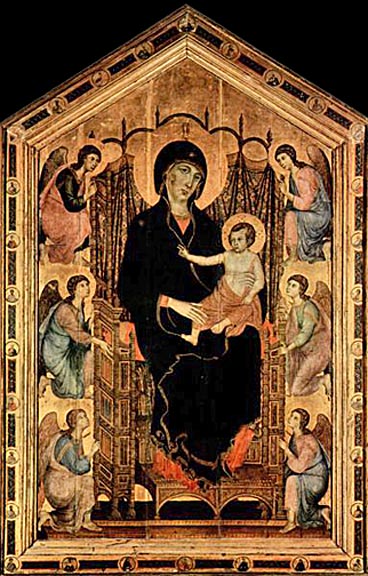-
Duccio di Buoninsegna 1260 - 1319
Duccio di Buoninsegna has, to my knowledge, left only one fresco in the Palazzo Publico of Siena, of which I cannot frind any reproductions. He was the first great Sienese painter, and he stands in relation to the Sienese School as Giotto does to the Florentine; yet without the powerful naturalism that makes the art of Giotto so revolutionary. Rather, Duccio sums up the grave and austere beauty of centuries of Byzantine tradition and infuses it with a breath of the new humanity which was being spread by the new Orders of SS. Francis and Dominic.
From the artistic point of view both sides show Duccio as a profound innovator, from the front his figures have greate weight and solidity, and more characterization, than had been seen previously in Siena; while their backs show him as a master of narrative, equal to Giotto in his power of story-telling though less fresh in iconographical invention, for Duccio was content to use the old Byzantine models for most (though not all) of his scenes from the New Testament. The superb craftsmanship, the use of gold as a decoration and a compositional feature at the same time, the rich and subtle colour which is made into an aesthetic feature in its own right, rather than treated (as in Giotto's works) as explaining the forms, and above all the use of varied and elegant outlines as a surface pattern as well as a description of form: all these features characterized the Sienese School for nearly two centuries. In the next generation artists as profoundly different as Simone Martini and the Lorenzetti started from aspects of Duccio's work, although the influence which Giovanni Pisano's sculpture had had on Duccio himself was also a potent factor in the development of Lorenzetti. Abbreviated from: Web Gallery of Art
Duccio's Madonna Ruccelai, Florence 1285
One of his first paintings, a panel painting commissioned by the fraternity of Santa Maria Novella in Florence, stands here as an example of his conservative style. Vasari ascribed it to the Florentine painter Cimabu! It was only restored to Duccio in the 20th cent. It now hangs in the Uffici.
